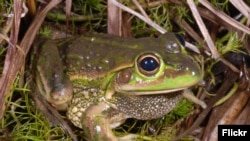Sydney's Taronga Zoo has released a specially-bred group of critically endangered yellow-spotted bell frogs into the wild. Yellow-spotted bell frogs were thought to have become extinct until a chance discovery a decade ago. It allowed scientists to breed a so-called insurance population' in captivity to help the species recover.
Historically, yellow spotted-bell frogs were found in two separate highland ranges in the north and south of New South Wales state in eastern Australia.
But disaster struck in the 1970s following an outbreak of an infectious disease that affects amphibians around the world.
For 30 years there were no recorded sightings of yellow-spotted bell frogs and scientists thought they were extinct.
However, a small group of these rare frogs was found near the New South Wales town of Yass in 2009 on the Southern Tablelands. Researchers moved quickly to harvest eggs and they became part of a so-called insurance population. It has been a success.This week experts from Taronga Zoo in Sydney released 200 juvenile frogs back into the area near Yass in an attempt to re-establish a wild population.
Michael McFadden is a supervisor at the zoo.
"In the Northern and Southern Tablelands this species used to be extremely common up until the late 1970s and at that time the species almost went extinct over a couple of years. So it disappeared, it was thought to have gone extinct. The reason for that decline was due to the introduction of an introduced pathogen called chytrid fungus. Unfortunately for this species they showed very little immunity and as a result they were wiped out over a period of one or two years," he said.
Insurance populations' of endangered Tasmanian Devils have also been bred in captivity in Australia. In the wild, the world's largest surviving carnivorous marsupial has been devastated by a contagious facial cancer that was first recognized in the 1990s. A small number of animals bred in captivity have been released into the wild, fueling hopes this iconic species can recover.
There are hopes, too, the yellow-spotted bell frogs can do the same.
Chytrid fungus causes chytridiomycosis, which has been described by scientists as one of the most devastating wildlife diseases ever known. It has devastated frog populations in Australia, Africa, Asia, the Americas and Europe.
New Hope for Frog Once Feared Extinct in Australia
- By Phil Mercer

SYDNEY, AUSTRALA —



